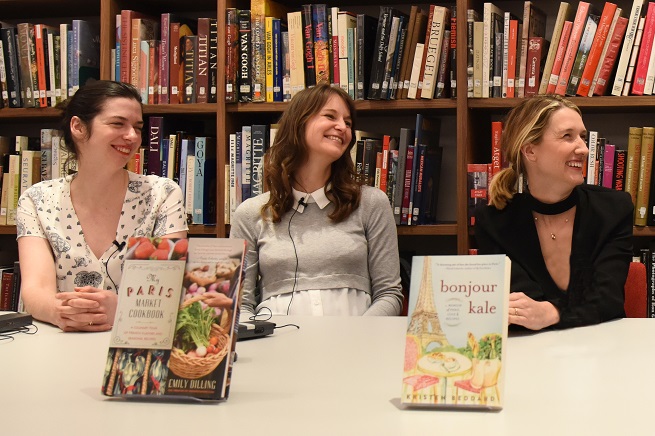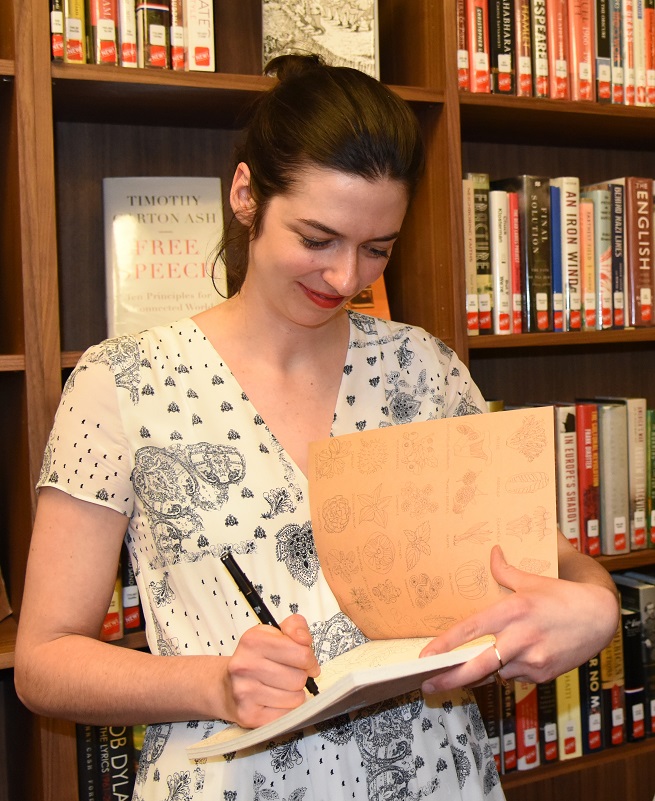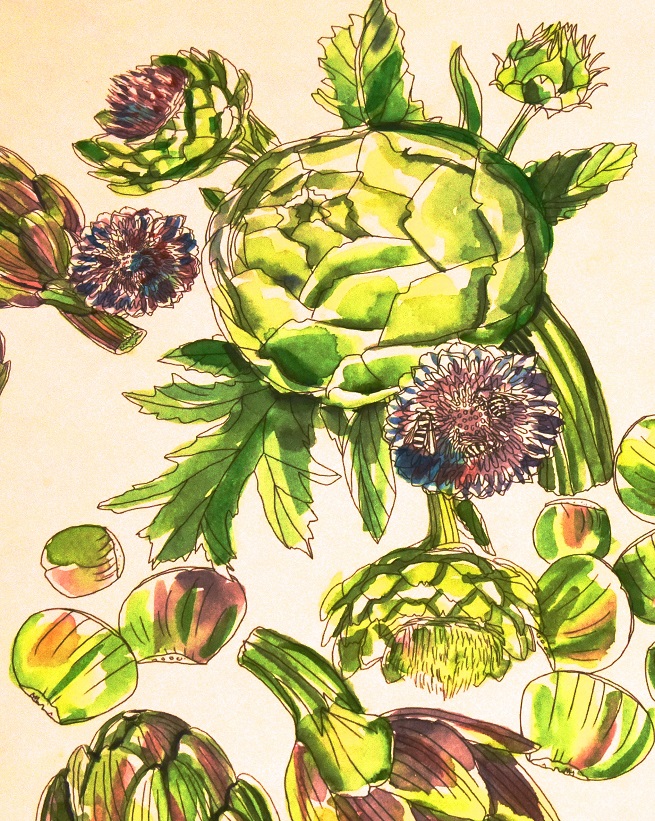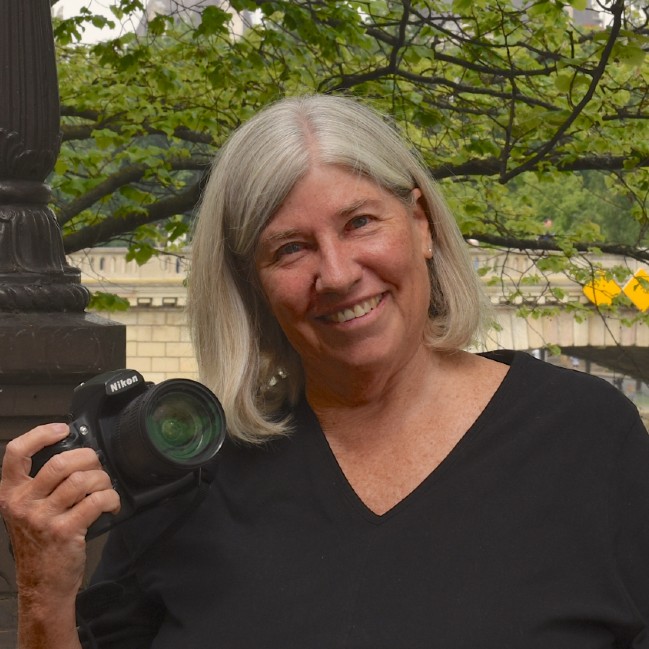The Ins and Outs of Local Market Produce in Paris
- SUBSCRIBE
- ALREADY SUBSCRIBED?
BECOME A BONJOUR PARIS MEMBER
Gain full access to our collection of over 5,000 articles and bring the City of Light into your life. Just 60 USD per year.
Find out why you should become a member here.
Sign in
Fill in your credentials below.

The Market Produce panel (l to r Jessie Kanelos Weiner, Emily Dilling, Kristen Beddard). Photo © Meredith Mullins
Four foodies walked into a bar. Never mind. That’s another story…
This story begins at a panel discussion at the American Library in Paris. Four food notables—Alec Lobrano, Kristen Beddard, Emily Dilling and Jessie Kanelos Weiner—examined the past, present, and future of local market produce in Paris.
How are our produce markets changing? What do we hope will stay the same? How are our food customs evolving? What drives this transformation?
Panel moderator Alec Lobrano—a food writer for several major publications and author of Hungry for Paris and Hungry for France—used inspiration from his home state of Connecticut to introduce the panel. The state motto there is “They who are transplanted are sustained.”
Hungry for France: Adventures for the Cook & Food Lover

Alexander Lobrano, photo © Meredith Mullins
Since all of the discussion participants were transplants to France from the U.S., the idea of “being sustained” was not just a metaphor for finding roots in their new adopted country and creating a successful path for themselves. It was also a literal reference to the pleasures of food in France.
The panel members each represent a different aspect of the food culture in Paris, but all value the French appreciation for fresh, seasonal, local produce and the focus on meals as a social pleasure.
Kristen Beddard is the founder of The Kale Project and author of Bonjour Kale. When she first arrived in France, she noticed that the U.S. superfood of the moment—kale—was nowhere to be found in Paris markets. It was a légume oublié … a forgotten vegetable. She vowed to change that. Let the kale crusade begin.
Bonjour Kale: A Memoir of Paris, Love, and Recipes

Kristen Beddard, photo © Meredith Mullins
She gave kale seeds to farmers, talked with market vendors, visited chefs, and made kale a community topic. Now, five years later, you can find kale (chou kale) everywhere. Her memoir tells the story of her quest, with its happy ending of a vegetable rediscovered.
Emily Dilling is the founder of Paris Paysanne and the author of My Paris Market Cookbook. Her blog led to a book deal that started out as a guide to off-the-beaten-path places in Paris. The book grew into a guide to markets, as well as a cookbook.
Since she did not consider herself an expert in cooking, the recipes are easy to prepare (my kind of cooking!)—a perfect way to take advantage of the essence of good products.

Emily Dilling, photo © Meredith Mullins
My Paris Market Cookbook: A Culinary Tour of French Flavors and Seasonal Recipes
She admits that her relationship to cooking has changed over the past few years. Now, she goes to the market with no shopping list, just a desire to choose what looks fresh and good and a desire to share that goodness with friends.
Jessie Kanelos Weiner is the author/illustrator of Edible Paradise. Her love of food emerges visually, as she outlines the produce of each season in coloring book style. At the library event, she displayed a completed book with her own delicate watercolors filling the pages.

Jessie Kanelos Weiner, photo © Meredith Mullins
Edible Paradise: An Adult Coloring Book of Seasonal Fruits and Vegetables
Paris Local Produce
We are lucky to have more than 60 open markets in Paris, varying their schedules to cover every day of the week (except Monday).
The panelists, however, acknowledged that the market environment changing.

Illustration by Jessie Kanelos Weiner
There are very few farmers at these farmer’s markets now. Even though the city favors local producers, the trend is for a few large distributors to dominate.
Also when you look beyond the facade of these picturesque open-air scenes, you find fruits and vegetables that are often shipped from afar, not seasonal local produce.
“For centuries Paris nourished itself,” Alec reminded the library audience. Now a trend toward global import is emerging, for better or for worse.
All the panelists acknowledged how difficult it is for modern farmers. Success is dependent on hard work and favorable climate. But the added demands of bringing the produce to the city markets three or more times a week make this way of life challenging. As a result, many farms are dying. The younger generation of farming families is reluctant to take on the challenges.
Some farmers have solved part of their problems by joining an AMAP network (Association pour le Maintien d’une Agriculture Paysanne). A direct contract between farmer and consumer results in fresh, seasonal (often organic) foods delivered directly from producer to consumer.
As several panel members noted, the weekly AMAP box can be “gastronomically challenging.” You don’t know what will be in your delivery. You must rise to the occasion (e.g., making creative use of the plethora of potatoes during the winter months).
Market Advice
The panelists gave advice for how to find the best produce at an open market:
- Look for the longest line, especially a line where the customers are chatting with one another as well as with the merchants.
- Find a merchant where you can ask questions and get thoughtful, honest answers.
- Look for stalls where the producer is present. Sadly, this has become more and more rare as the rigors of farming and attending daily markets are too demanding.
- Remember that every time you buy something, you’re voting. So vote for the best. (Words of wisdom from Alec Lobrano)

Illustration by Jessie Kanelos Weiner
Favorite Markets
What are the favorite markets of the panel members?
Président Wilson
Avenue du Président Wilson between rue Debrousse and place d’Iéna, 75016 Paris.
Wednesdays 7:00 am to 2:30 pm and Saturdays 7:00 am to 3:00 pm
Raspail (organic)
Boulevard Raspail, between rue du Cherche-Midi and rue de Rennes, 75006 Paris.
Sundays 7:30 am to 2:00 pm
Batignolles (organic)
34 Boulevard des Batignolles, 75017 Paris.
Saturdays 7:30 am to 2:00 pm
Bastille
Boulevard Richard-Lenoir, between rue Amelot and rue Saint-Sabin, 75011 Paris.
Thursdays 8:00 am to 2:00 pm and Sundays 7:00 am to 3:00 pm
Ornano
Boulevard Ornano, between rue du Mont Cenis and rue Ordener, 75018 Paris.
Tuesdays and Fridays 7:00 am to 2:30 pm and Sundays 7:00 am to 3:00 pm
Emily particularly likes the Ornano Market, which she describes in one of her Paris Paysanne blog posts, because it includes two producers from the Ile de France (one from Val d’Oise and one from Cergy-Pointoise) who sell their own home-grown produce (and offer cooking advice!).
A Tribute to the French Way of Life
The three panelists—all charming, young movers and shakers in the food world—are old enough to feel a nostalgia for the good old days. They know that times are changing.
What do they miss most, especially when they’re away from France?
Emily, who now lives in the French countryside, misses the full sensory experience of eating in a Paris bistro. The sounds, the smells, the interactions, the slow pace of dining to enjoy every sense.

Illustrations by Jessie Kanelos Weiner
Jessie treasures the changing seasons, especially that each season offers something new to experience.
Kristen embraces French traditions and even sheds a tear when she thinks about légumes oubliés.
In her current New York world, she laughs that take-out is king and that there is an appalling app where you can order your restaurant food in advance so that it’s waiting for you at the table when you arrive. No aperitif. No “How was your day?”
She misses a culture where food is about much more than eating, about more than what is in front of you on the table.
It is about everything that surrounds you and about sharing the experience with friends and family.
The American Library hosts a variety of evening events.
Related sites of interest for local produce:
La Ruche
Lead photo credit : ®Mullins




REPLY